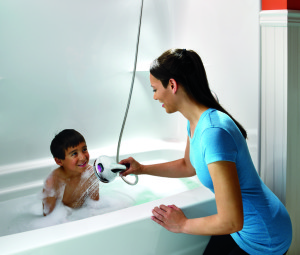Although most consumers are happy to embrace low-flow showerheads for water savings, these fixtures still need to meet consumers’ expectations in regards to performance. A typical showerhead uses 2.5 gallons of water per minute, a WaterSense-labelled showerhead operates at 2 gallons minute.
“While it’s using less water, it has to have the same feel 2.5 gallon per minute standard,” says Gary Scott, Moen vice-president of wholesale marketing and branding. “So is to try and balance what consumers are looking for, which great coverage and feel in the shower, but be mindful of environment at the same time.”
Scott says using WaterSense-labelled fixtures can equate big water savings for homeowners, especially since a typical family uses about 80 gallons of water per day in the shower bathroom.
“That’s about 37 per cent of their overall water consumption from showers and baths – mostly from showers,” he says.
There are a variety of technologies companies are using to find this balance, including manipulating the speed, movement and droplet size of water through the use of air pressures and nozzle patterns.
“Water enriched with air makes the water droplets plumper, lighter and softer, and that means that the water can be used more effectively,” says Kathryn Holman, showroom supervisor at Desco’s The Water Closet in Kitchener, Ont.
A WaterSense-able program
One of the biggest initiatives taken in North America to conserve water is the WaterSense labelling program, which was developed by the U.S. Environmental Protection Agency, and adopted in Canada. The program is designed to promote the value of water efficiency by acting as an educational resource for homeowners and providing consumers with ways to save water through product labelling on appliances and fixtures that use water.
One of the places in the home that the WaterSense program focuses is in the bathroom, and the shower is big part of that.
A standard showerhead in a residential household uses 2.5 gallons of water per minute. To obtain a WaterSense label, a showerhead must operate at a maximum of 2.0 gpm. For lavatory faucets and faucet accessories, the maximum flow rate cannot surpass 1.5 gpm tested at a flowing pressure of 60 pounds per square inch (psi).
Design and finishing trends
A more modern look continues to be popular among Canadian consumers when it comes to the bathroom, and showerheads are no exception.
“The look, shape and design of the showerhead are as important as the spray pattern,” says Moen’s Scott. “Consumers are spending more time and thought on this.”
“Designers have always loved to take risks with faucet styles and finishes but we’re now seeing this move into the shower space,” adds Masco’s Krystin Lee, who says her company has experienced an increase in demand for showerheads with such finishes as matte black and bronze. She says those finishing options stand out against versatile backdrops, such as white subway tile.
Both Scott and Wolseley Canada’s Bruce Mole say chrome is another extremely popular choice among Canadian consumers.
“Chrome is very popular because you can then change the décor in the room without having to redo the whole bathroom again,” says Mole.
Steam shower units and custom built, walk-in showers with such fixtures as overhead rainshowers have also been increasing in popularity, adds The Water Closet’s Holman.
Tips for plumbers
Masco Canada’s Lee recommends that plumbers sit down with their clients and review how they intend to use the shower space prior to installation of any fixtures or shower systems.
“Placement of body sprays or the showerhead height can often vary from one family to the next,” she says.
Another reason to find out a family’s water consumption habits is to ensure they have a hot water delivery system in place that can keep up with any additional demand being created through the installation of new shower systems. This sometimes means going back to basics and educating the homeowner, says Wolseley Canada’s Bruce Mole, branch manager for the company’s Milton, Ont. location.
“When it comes to designing showers and wet rooms for customers, we need to make sure the system that they have is going to cope with what they want,” says Mole. “It’s not good having a wet room with a 25-gallon per minute showerhead with body sprays when they’ve only got a 40-gallon water tank. It’s just not going to work… you’re only going to get out what you put in.”
Garry Scott adds that homeowners should seek out a plumber that’s familiar with the type of shower system they are interested in, and work with them to design a system that fits their needs.
Washing away a stressful day
Moen Canada regularly conducts surveys asking consumers a wide variety of questions regarding their fixture choices for the kitchen and bathroom. One common response from customers that were asked about their shower experiences was that their showers are a place for relaxation at either the beginning or end of their day.
“Sixty-seven per cent of respondents told us they like to dream or think in the shower, and 40 per cent of those people imagine where they could travel,” says Garry Scott. “We found it interesting that the shower was a place of refuge.”
Did you know?
Since WaterSense’s inception in 2006, it has helped consumers save 757 billion gallons of water and more than $14.2 billion in water and energy bills.
Written by Andrew Snook



